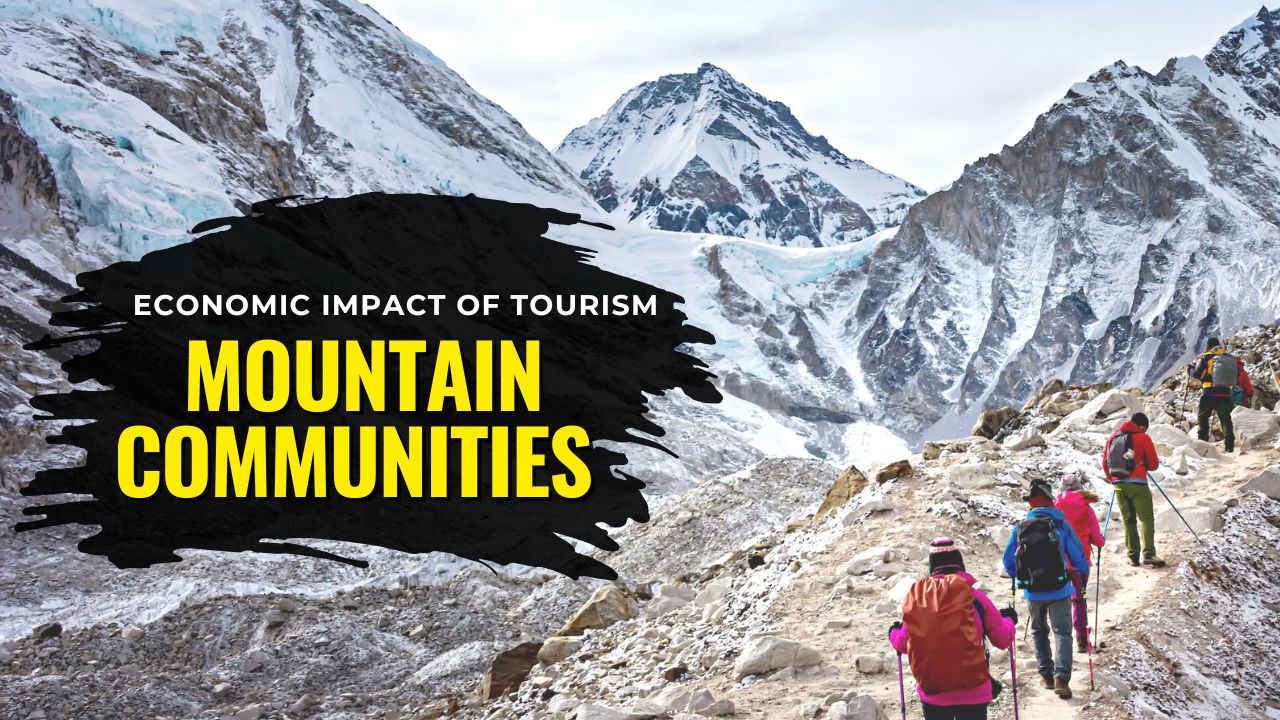Mountain destinations — from the Rockies to the Himalayas — are experiencing a robust rebound in 2025.
Visitor spending is proving essential for local employment, small-business revenue, and public services, even as mountain towns grapple with shifts in international demand, short-term rental regulations, and climate unpredictability.
While tourism is recovering globally, the economic dynamics in high-altitude, rural regions are uniquely complex.
Global Momentum- Tourism Returns Strong
- International arrivals are up about 5% in the first half of 2025 compared with 2024, placing current volumes roughly 4% above their 2019 baseline.
- In winter sports, the U.S. recorded 61.5 million skier visits in 2024–25 — the second-highest on record — fueling lodging, dining, and retail sectors across mountain regions.
These macro trends create favorable tailwinds for mountain towns, funneling more potential customers into lodging, food & beverage, recreation, and transportation sectors.
Colorado Case Study- Big Numbers, Local Nuance
Colorado often serves as a bellwether for high‐altitude tourism economies. In 2024, the state welcomed 95.4 million visitors who collectively spent $28.4 billion, generating $1.9 billion in state and local tourism tax revenue (up ~1.3% year over year).
But within those big aggregates lie softer signals:
- By mid-2025, hotel occupancy in many mountain towns was down ~2%, and short-term rental bookings in Q1 were down ~10% year over year.
- During the 2024–25 ski season, 13.8 million visits were recorded — slightly below recent peaks but still above long-term averages.
- Across dozens of mountain towns, net taxable sales from November through April hit $5 billion — a drop of about $2 million from the prior season, but about 48% higher than 2018–19 levels.
- One significant driver: fewer international visitors (whose average stay and per-day spend are higher) have had a disproportionately large effect on overall revenues.
For many businesses, these shifts highlight how visitor mix can matter more than raw headcount.
Europe’s Alps- Steady, But Warnings Below The Snowline
In the Alpine region, visitor volumes have remained strong:
- Austria reported a record number of winter overnights in the early 2024/25 season and recorded 116.02 million overnights from January to August 2024 — a modest 0.3% increase over the prior period.
- However, early 2025 signals some softness, especially in shoulder seasons, making revenue forecasting trickier for mountain towns reliant on both winter and summer traffic.
Himalayas And South Asia- Volume, Risk & Resilience
- In India, domestic tourism continues to surge in 2025. Over 300 billion domestic visits (on cumulative basis) by August are helping fuel mountain circuits in Uttarakhand, Himachal Pradesh, Kashmir, and the Northeast. Homestays, rural guesthouses, local guides, transport operators, and small shops are key beneficiaries.
- Nepal is seeing a strong rebound: approximately 815,000 tourist arrivals Jan–Sept 2025, with ~78,700 in September alone. The trekking sector is bouncing back, though monthly volatility and uneven flows remain.
- Climate and weather risk loom large. Recently, unseasonal storms in the Everest region triggered mass rescues, adding dramatic costs and reputational damage. Sudden shocks like these force destination managers to reassess infrastructure resilience, insurance exposure, and emergency capacity.
How Visitor Dollars Flow Through Mountain Economies
The economic benefit of tourism in mountain communities cascades across sectors:
- Lodging & Short-Term Rentals
Tourist room nights generate occupancy taxes and licensing fees. These funds often support trails, local transit, public safety, and infrastructure upkeep. Caps or restrictions on short-term rentals can moderate crowding—but may also shrink the tax base, complicating municipal budgets. - Food & Beverage
Restaurants and cafes often enjoy high margins during peak visitor periods. However, staffing, food supply logistics, and wage stability depend heavily on predictable visitation patterns. - Outdoor Recreation & Guiding
Guided hikes, ski lessons, rafting, biking, and outfitter services are integral. These often provide entry-level jobs and create downstream demand for gear shops, transport, and maintenance. - Retail & Gear Sales
Mountain towns often rely on income from apparel, equipment, souvenirs, and accessory sales. The timing of snow, summer sports, and adventure trends heavily influence retail patterns. - Transportation & Logistics
Shuttle services, local transit, regional flights, and ride-hail benefit when traffic is synchronized with lodging and events. Delays or cancellations due to weather or infrastructure strain have ripple effects up and down the value chain. - Public Revenues & Services
Even a small percentage change in visitor spending can mean millions in tax revenue for small mountain jurisdictions. That money sustains trail maintenance, emergency services, sanitation, local road upkeep, and capital investment.
2025 Realities That Shift The Balance
- Changing demand mix: Though visitor totals are rising, the composition is shifting. Fewer long-haul travelers and more day-trippers mean weaker average revenue per visitor.
- Pricing pressure: Many destinations increased rates over recent years. Now, occupancy softness challenges whether those price levels are sustainable.
- Seasonal volatility: Peak ski numbers may coexist with summer or shoulder-season soft patches. Businesses must manage cash flow, staffing, and inventory under that uncertainty.
- Climate adaptation imperative: Reduced snow reliability, shifting weather patterns, and extreme event risk push mountain destinations toward diversification: more four-season offerings (culture, wellness, conferences, biking) and resilient infrastructure.
Best Strategies For Sustainable Growth
- Prioritize high-value visitor segments
Concentrate on travelers who stay longer and spend more (international, adventurous, niche interest) rather than chasing mass numbers. - Smooth demand across seasons
Use events, festivals, remote-worker incentives, and off-peak packages to stabilize year-round flow. - Dynamic, data-driven pricing
Adjust rates in real time to occupancy, booking pace, and weather cues—rather than sticking rigidly to flat seasonal pricing. - Invest in workforce housing & stability
Affordable seasonal housing helps ensure consistent staffing and helps businesses survive slow weeks. - Year-round product diversification
Trail systems, wellness retreats, heritage tours, cultural programming, and biking can help offset declining snow days. - Resilience, not just revenue
Infrastructure investment, disaster preparedness, and environmental stewardship protect a mountain town’s long-term reputation and operations.
Quick Snapshot- 2025 At A Glance
| Metric / Region | Latest Value | Implication for Mountain Economies |
|---|---|---|
| International arrivals growth (H1 2025) | +5% | Signals higher baseline demand for mountain destinations |
| U.S. skier visits (2024–25) | 61.5 million | Supports winter businesses in snowbelt communities |
| Colorado tourism tax revenues (2024) | $1.9 billion | Demonstrates how visitor taxes fund public services |
| Colorado mountain town sales (Nov–Apr) | $5 billion | High relative to pre-pandemic; growth is softening |
| Hotel occupancy trend mid-2025 | –2% | Suggests caution is needed in rate forecasts |
| STR booking drop Q1 2025 | –10% | Indicates sensitivity to booking windows and visitor mix |
| Austria overnight stays Jan–Aug 2024 | 116.02 million | Stable Alpine demand; pressures in shoulder months |
| India domestic visits by Aug 2025 | > 300 billion cumulative visits | Strong U.S. and South Asia travel base for mountain circuits |
| Nepal arrivals Jan–Sept 2025 | ~815,000 | Trekking sector rebound, though volatile monthly flow |
| Everest region storm event Oct 2025 | Mass rescues, stranded climbers | Dramatic reminder of climate and risk variables |
In 2025, mountain tourism is oscillating between revival and recalibration.
The macro momentum is positive, driven by recovering international travel and strong winter activity. But at the community scale, success requires deliberate strategies.
Mountain towns that focus on high-value guests, smooth seasonal flows, smart pricing, diversification, and resilience will be best positioned to convert visitor numbers into sustained prosperity.
Tourism can be a powerful engine—but only if managed with both ambition and prudence.
FAQs
Which visitor groups drive the most economic impact?
International travelers and multi-day adventure tourists contribute disproportionately through longer stays and higher per-capita expenditure. Day-trippers help with numbers but rarely generate equivalent revenue.
Why might a mountain town face a slowdown even when national tourism is strong?
Because local outcomes depend on visitor mix, pricing, housing and STR policy, and weather-dependent risk. Even in a banner national season, weaker summer or shoulder periods and fewer international guests can squeeze margins.
What types of investments best protect a mountain economy’s future?
Workforce housing, four-season product development (trail networks, wellness, culture), smart transit, climate resilience, and emergency infrastructure help stabilize long-term jobs and taxes.

